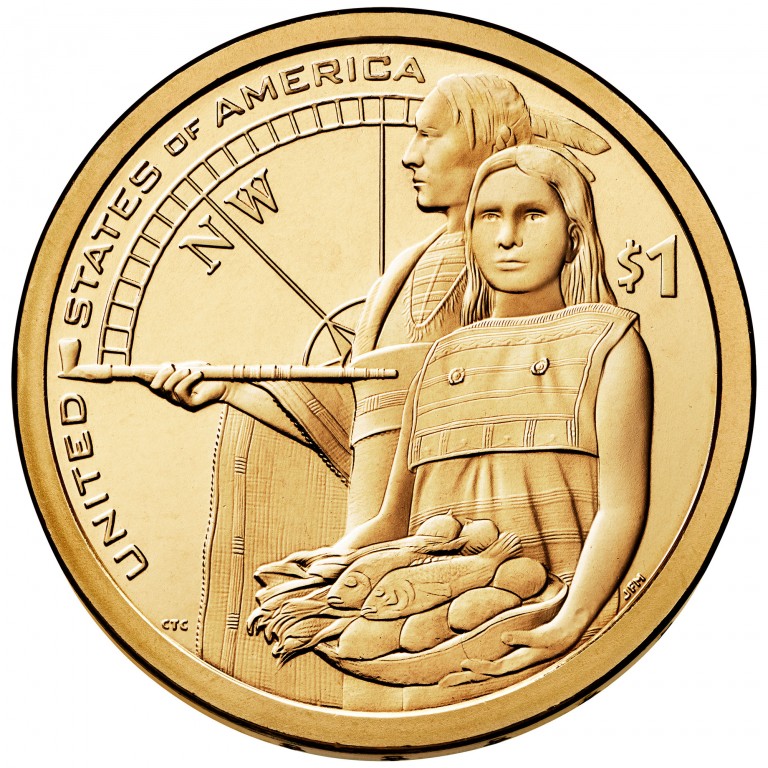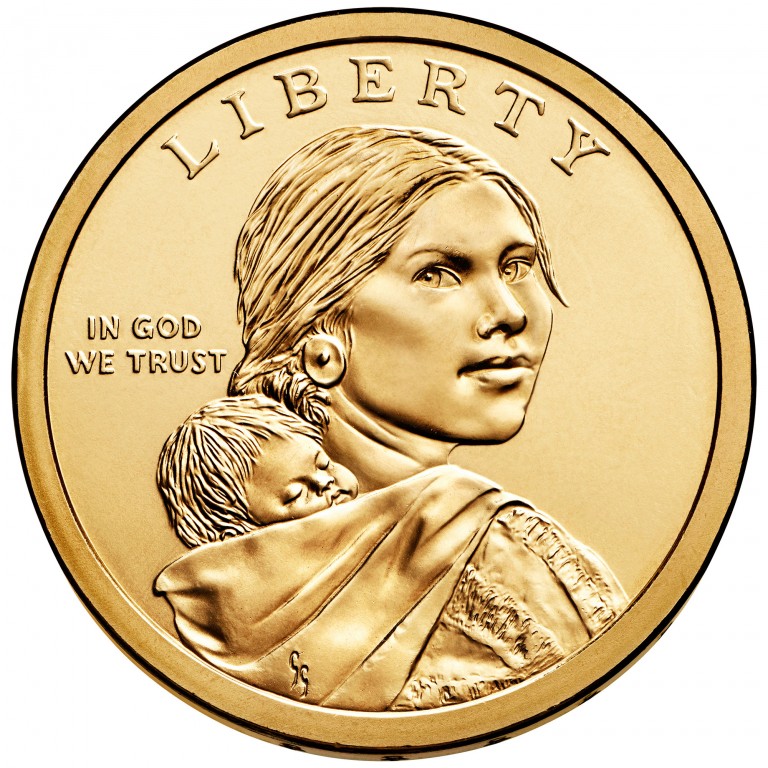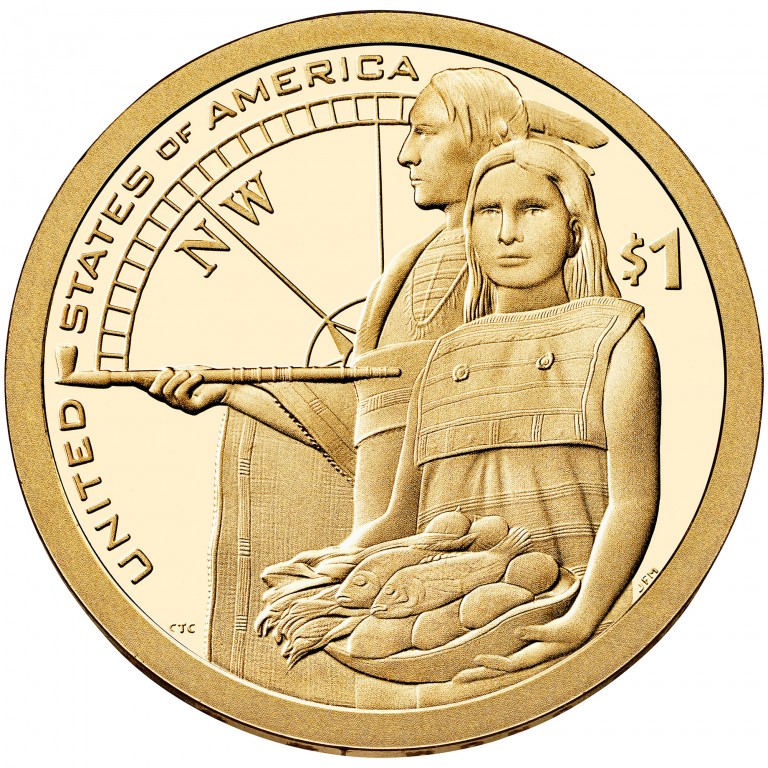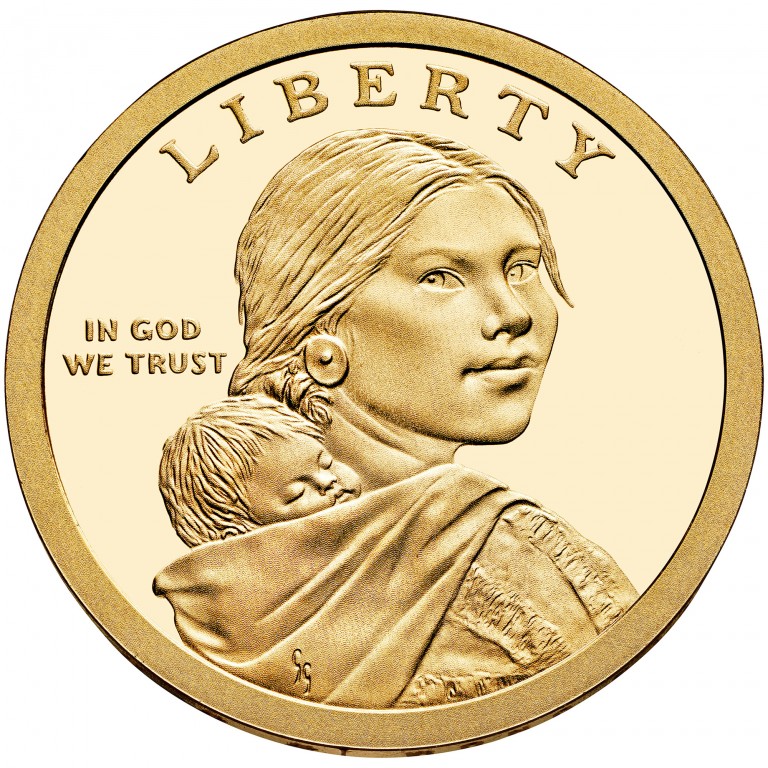2014 Native American $1 Coin
- Year of Issue: 2014
- Authorizing Legislation: Public Law 110-82
- Shop Now
Background
The 2014 Native American $1 Coin commemorates how Native American hospitality ensured the success of the Lewis and Clark Expedition.
When the Lewis and Clark Expedition crossed the Continental Divide, the nature of its mission fundamentally changed. Up to that point, it had been exploring territory that European powers would recognize as belonging to the United States through the Louisiana Purchase. Once past the headwaters of the Missouri River, the expedition was securing the American claim to a new accession of territory, the Pacific Northwest.
More than ever before, success of the mission depended on help from the Indian tribes, who might not have understood the long-term consequences of their hospitality. For every step of their way through the Rocky Mountains to the Pacific Coast, Lewis and Clark depended on the friendship, supplies and logistical support of the tribes on their route. They camped in the midst of the Mandan and Hidatsa tribes in the winter of 1804-05 and the Clatsop in 1806, and their cooperation was essential to the resounding success of this mission.
Contribution
The Mandan and Hidatsa tribes of the Missouri River welcomed Lewis and Clark and their Corps of Discovery to their unique dome-shaped earthen lodge villages, often sitting and talking by the campfire when meeting with Black Cat, the Mandan chief. The tribes were located in present-day North Dakota. Their village was the central marketplace for the northern plains.
Lewis expressed the highest respect for Black Cat (Posecopsahe) and walked miles out of his way to smoke a pipe with him on the day of his departure. The expedition group traded for corn and gathered every scrap of intelligence they could about the route ahead.
During the winter at Fort Mandan, the expedition blacksmith forged somewhat eccentric ax heads to trade for corn. Eighteen months later, the expedition found that some of the same ax heads had already been traded to the Nez Perce, which the expedition relied on to supply horses from their famous herd. Down the length of the Columbia River, the Americans traded with the Chinook and other tribes for provisions.
The Clatsop Indians were flourishing people who enjoyed plentiful amounts of fish and fur and occupied three villages on the southern side of the Columbia River. They were located in what is now known as Oregon. Some Clatsop tribesmen complained about the expedition’s stinginess with gifts. Coboway, chief of one of the villages, visited the expedition group at its fort, which was still under construction. He exchanged some goods, including a sea otter pelt, for fishhooks and a small bag of Shoshone tobacco. Over the rest of the winter, Coboway would be a frequent and welcome visitor to this area they named Fort Clatsop.
The Clatsop also aided the expedition both in preparing for, and dealing with, the northwest winter and informed Lewis and Clark that there was a good amount of elk on the south side of the Columbia, information that influenced the construction of Fort Clatsop where they did. When the expedition’s food supplies were running low, the Clatsop informed the corps that a whale had washed ashore some miles to the south.
At the expedition’s departure from Fort Clatsop, Lewis wrote in his journal that Coboway “has been much more kind an[d] hospitable to us than any other indian in this neighbourhood.” Lewis committed the expedition’s one act of pilferage, appropriating a Native canoe for the voyage up the river. (He later encountered a Lumhi Indian who claimed ownership of the vessel and paid him off with an elk skin.) This misdeed remained on the historical record, and late in 2011, the family of William Clark presented a replica of the original canoe to the Chinook tribe in recompense.
Characteristics
The obverse design retains the central figure of the “Sacagawea” design first produced in 2000. It features Sacagawea carrying her infant son, Jean Baptiste.
The reverse design depicts a Native American man offering a pipe while his wife offers provisions of fish, corn, roots and gourds. In the background is a stylized image of the face of William Clark's compass highlighting "NW," the area in which the expedition occurred.
Obverse Inscriptions
- LIBERTY
- IN GOD WE TRUST
Reverse Inscriptions
- UNITED STATES OF AMERICA
- $1
Incused (edge) Inscriptions
- 2014
- Mint mark
- E PLURIBUS UNUM
Mint and Mint Mark
Specifications
| Composition | Weight | Diameter | Thickness | Edge | No. of Reeds |
|---|---|---|---|---|---|
|
Manganese-Brass
88.5% Cu
6% Zn
3.5% Mn
2% Ni
|
8.1 g |
1.043 in.
26.49 mm
|
2.00 mm | Edge-Lettering | N/A |
Artist Information
Obverse- Designer: Glenna Goodacre
- Sculptor: Joseph Menna, Medallic Artist
- Designer: Chris Costello, Artistic Infusion Program






